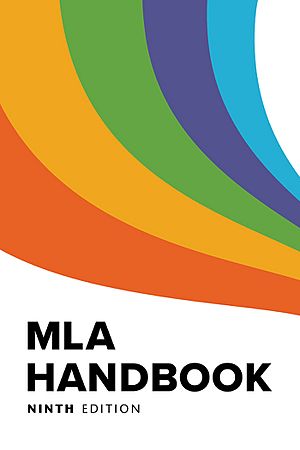MLA style facts for kids
The MLA Handbook is a super helpful guide for students and writers. It teaches you how to properly give credit to the sources you use in your school projects, essays, and research papers. This way, you avoid accidentally copying someone else's work, and your teachers can see where you got your information. It's mostly used in subjects like English, literature, and media studies.

MLA Handbook, 9th ed.
|
|
| Original title | MLA Handbook for Writers of Research Papers |
|---|---|
| Country | United States |
| Language | English |
| Subject | Style guide |
| Publisher | Modern Language Association of America |
|
Publication date
|
2021 |
| Pages | xxx + 367 |
| ISBN | 9781603293518 |
| LC Class | LB2369 .M52 2021 |
The MLA Handbook helps you write research papers and essays. It shows you how to correctly list the books, websites, and other materials you use. This is called "citing sources." Citing sources is important because it gives credit to the original authors. It also helps readers find the information you used. This style is popular in subjects like English, modern languages, and cultural studies.
There used to be another book called the MLA Style Manual. That book was for grown-up scholars and professional writers. The MLA Handbook has always been made for students like you and your teachers.
How the MLA Handbook Started
The MLA Handbook started from a small guide in 1951. It was only 28 pages long. The first five editions, from 1977 to 1999, had a longer title. They were called MLA Handbook for Writers of Research Papers, Theses, and Dissertations.
The sixth edition came out in 2003. Its title became shorter: MLA Handbook for Writers of Research Papers.
Changes Over Time
The seventh edition (2009) made some important changes. It asked writers to always say if their source was a book, a website, or a CD. It also suggested not using long web addresses (URLs) in your list of sources. Instead, it preferred using italics for titles, not underlines. This edition also came with a website that had the whole book online. Later, it added rules for citing e-books and even social media posts.
The eighth edition (2016) changed how you list your sources even more. It focused on the main goal of citing sources: to help readers find them. This edition added abbreviations for things like "volume" (vol.) and "pages" (p. or pp.). It also started using URLs more often, but it preferred special ID numbers called DOIs.
The ninth edition (2021) is the most recent one. It gives even more examples to help students. It also suggests using more inclusive language in your writing. This edition says that URLs are optional. It prefers DOIs or permanent links instead. The ninth edition also added rules for a special kind of list called an "annotated bibliography." This list includes a short summary of each source.
Editions List
Here is a list of when each edition of the MLA Handbook was published:
| Edition | Year |
|---|---|
| 1 | 1977 |
| 2 | 1984 |
| 3 | 1988 |
| 4 | 1995 |
| 5 | 1999 |
| 6 | 2003 |
| 7 | 2009 |
| 8 | 2016 |
| 9 | 2021 |
Related Topics
- Parenthetical referencing
- APA style

